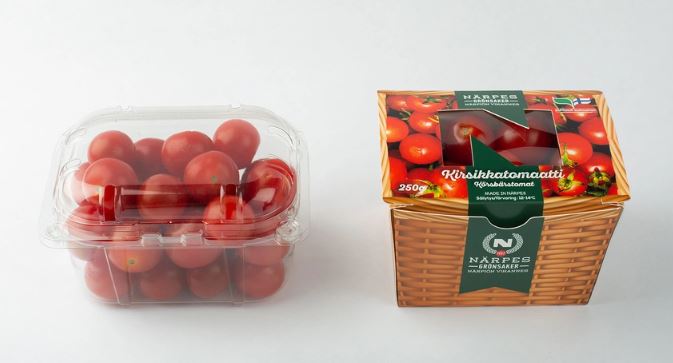Metsa Board and a Finnish vegetable cooperative commissioned a study to compare cherry tomato packages made of paperboard to one made of recycled PET plastic.
At a Glance
- Sustainable paperboard is revolutionizing food packaging freshness and safety
- Consumers prefer paperboard as a responsible, eco-friendly choice
- Paperboard packaging lowers the environmental impact versus plastic
The journey of produce from farm to table is a complex one, with packaging playing a crucial role in ensuring that fruits, vegetables, and other food items arrive in optimal condition. There has been a recent and significant shift to paperboard packaging in the food industry. This change is driven by a multitude of factors including produce preservation, food safety, environmental concerns, and consumer behavior.
One of the primary considerations for produce packaging is maintaining its freshness.
Different produce items have varied sensitivity to factors like humidity loss and oxidation. For instance, berries and mushrooms lose moisture faster than apples or oranges. Packaging materials are required to have suitable barrier properties to preserve the freshness of the produce and protect it from mechanical stresses during transportation, thus preventing food waste.
Regulatory diversity complicates food safety in global supply chains.
When it comes to direct contact with food, packaging must adhere to stringent safety measures. This includes using materials that do not transfer harmful substances or odors to the food. Compliance with international safety standards through rigorous testing is essential. The global landscape of food packaging regulations is complex, with different regions having varying standards. In Europe and the US, for instance, there are strict limits on substances like Optical Brightening Agents (OBAs) and Bisphenol-A, ensuring high safety standards. This diversity in regulations highlights the complexity of ensuring food safety in global supply chains.
Related:Is Recycled Paperboard Safe for Food Use?
The shift from plastic to paperboard packaging is driven by environmental concerns. Paperboard, derived from renewable resources, contrasts with plastic, predominantly produced from fossil fuels. This shift aligns with global efforts to minimize environmental impact and reduce dependency on non-renewable resources. Paperboard also boasts a high recyclability rate, contributing to circular economy principles.
Paperboard’s advantages go beyond sustainability.
However, paperboard’s advantages are not limited to environmental benefits. Various surface treatments also provide necessary barrier properties against moisture and oxygen. Innovations in water-based barrier coatings and biodegradable linings are enhancing paperboard’s functionality.
Paperboard graphics and printing have also evolved to combine visual appeal with environmental responsibility. Modern printing technologies allow for high-quality, vibrant graphics without compromising the recyclability of paperboard. This makes it a preferred choice for brands aiming to balance aesthetic appeal with environmental consciousness.
METSA BOARD
The choice between fresh and recycled fiber in paperboard is influenced by safety and environmental considerations. Fresh fiber, used for direct food contact, offers higher purity and traceability, free from contaminants often found in recycled fibers. Both have critical roles to play in keeping the circular system going, but recycled fiber is less suitable for direct food contact, and, while it can be used for non-food packaging applications, in a lifecycle analysis its carbon footprint is still higher than fresh fiber.
While paperboard solutions are typically heavier than plastic, they can be delivered flat, reducing transportation space, and potentially offsetting the weight disadvantage.
Kraft liner is particularly useful for producing corrugated boxes, which is ideal for larger, heavier produce. Corrugated boxes may also need internal or surface barrier treatments to protect the produce from the environment. The recyclability of paperboard is a significant aspect of its sustainability because it fits well within the existing recycling infrastructure, unlike materials with lower recycling rates.
Paperboard vs. plastic: A tomatoes-to-tomatoes comparison.
There are notable market examples where paperboard packaging has been successfully implemented. For instance, Metsa Board, together with Narpes Grönsaker, a Finnish vegetable cooperative, commissioned a study in 2019 to compare cherry tomato packages made of paperboard with a package made of rPET plastic. The study looked at consumer perceptions, food waste aspects and climate impact. The package made of paperboard included a transparent window, as consumers expect to be able to see produce before making any purchase decisions.
The study revealed that:
• Consumers regard paperboard as a more responsible choice than plastic packaging: 67% preferred the paperboard carton with a window. Paperboard packaging is perceived as convenient, innovative, aesthetic, and responsible.
• Shelf-life testing of cherry tomatoes in various packages carried out by The Natural Resources Institute of Finland (Luke) revealed no major differences in shelf life: paperboard packaging preserved tomatoes at least as well, or even better, than rPET. The best results were obtained with a dispersion barrier paperboard.
• The climate impact (CO2 equivalent) of the production of cherry tomatoes and their consumer packages revealed that the climate effect of the rPET plastic box was six times higher than that of the paperboard carton.
Consumer behavior plays a crucial role in the success of paperboard packaging. Consumers generally view paperboard as a more responsible choice due to its recyclability.
However, the effectiveness of recycling depends on consumer participation in waste sorting and access to waste recycling systems.
Therefore, paperboard is a viable, sustainable option for food packaging that addresses produce preservation, food safety, environmental impact, and consumer preferences. Its success, however, hinges on continued innovation in material science, responsible consumer behavior, and harmonization of global food safety standards.
Source:
https://www.packagingdigest.com/food-packaging/food-packaging-faceoff-paperboard-versus-rpet-plastic







